HOW DID THIS HAPPEN?
The Siamese was one of the earliest breeds to be recognized. A small percentage of the cats found in the Far East still show one or more of the present albinism factors in cats: (Burmese), (Siamese) or (Blue eyed white). Two of these phenotypes were picked up by westerners and came to breed status. The cats with the darkest points were taken by British, French and American living there for various reasons, and were brought or sent back to the respective home countries from roughly 1880 to 1930. Some of these cats were Tonkinese or pseudo-Siamese. Initially this was not understood or even considered by the general public. The pointed ones were preferred and bred on.
In the 1930’s an American brought the darkest form to the U.S. and this turned into the Brumese. In the Far East countries all kinds of pointed “Siamese” (with white, with striped, tortie-point, diluted, Chocolate point, Etc.) were and still are found. Only the Seal Point was chosen. As expected, recessives secretly snuck in any way as they were brought along secretly carried by the Seal points. Eventually the Siamese breed became accepted with 4 point colors, which is a situation that stuck until the fifties of the previous century.
Until the 1950’s breeding went on well all over the world. Then health problems began to appear, such as decreased litter sizes, limited fertility and other problems. These were signs on the wall. This is not very surprising because the breed worldwide had become intermingled due to import and export and also it was caused due to only a very, very small number of ancestors. No one knows for sure, yet a good guess would be that about 80 cats had been brought to England, another 30 or so to France and another 50 to the U.S.A. Optimistically guessing about 50% of those ancestors were used for breeding. Many cats died after arrival at their destination countries of infectious diseases and worms. No drugs were available at those times. Several imports were full brother and sister too. The initial forebears of the breed were less than about 75 cats worldwide. Breeding based on a selection for beauty only made matters worse. This became a plague caused by locked in genetic defects by generations of in-breeding.
Then cats being cats, crosses between Siamese and tabby housecats produced a second generation of pointed cats with stripes in mask and on the legs and tails. Other crosses with red housecats produced Tortie, Torbie, Cream and Red points. Some of these breedings were incidental and some were planned. This broadened the gene pool, but affronted many purists. The boost of several influxes of unrelated house cat blood improved genetic resistance and wellness, especially the tabby points in England, where they saved the breed by often giving new life to beautiful lines that had began to literally whither away. It was at this time that falsification of Registration Applications and pedigrees began. Fraudulently writing colors different than what the cat was removed the dreaded red and stripes to a politically accepted solid color instead. Thankfully these “other color points” are recognized and admired in TCA, INC. as the Colorpoint Siamese breed name.
Over time the look of the Siamese became changed into a form more and more extreme until the breed went into serious decline everywhere. Once a very popular breed for decades, they became a minority breed all over the world with fewer and fewer breeders staying with the breed and often leaving after a few short years and never passing on information or history, since they themselves did not know more than fragments. Part of the decline was the very small group of ancestors without much added un-related blood since about 1930. From that period onward almost no one returned to the Far East to get new cats. It was impossible when working with a locked in totally interrelated and inbred blood stock to reverse the tide of more than 100 years of in breeding and the focus on striving to turn the breed into a freak!


